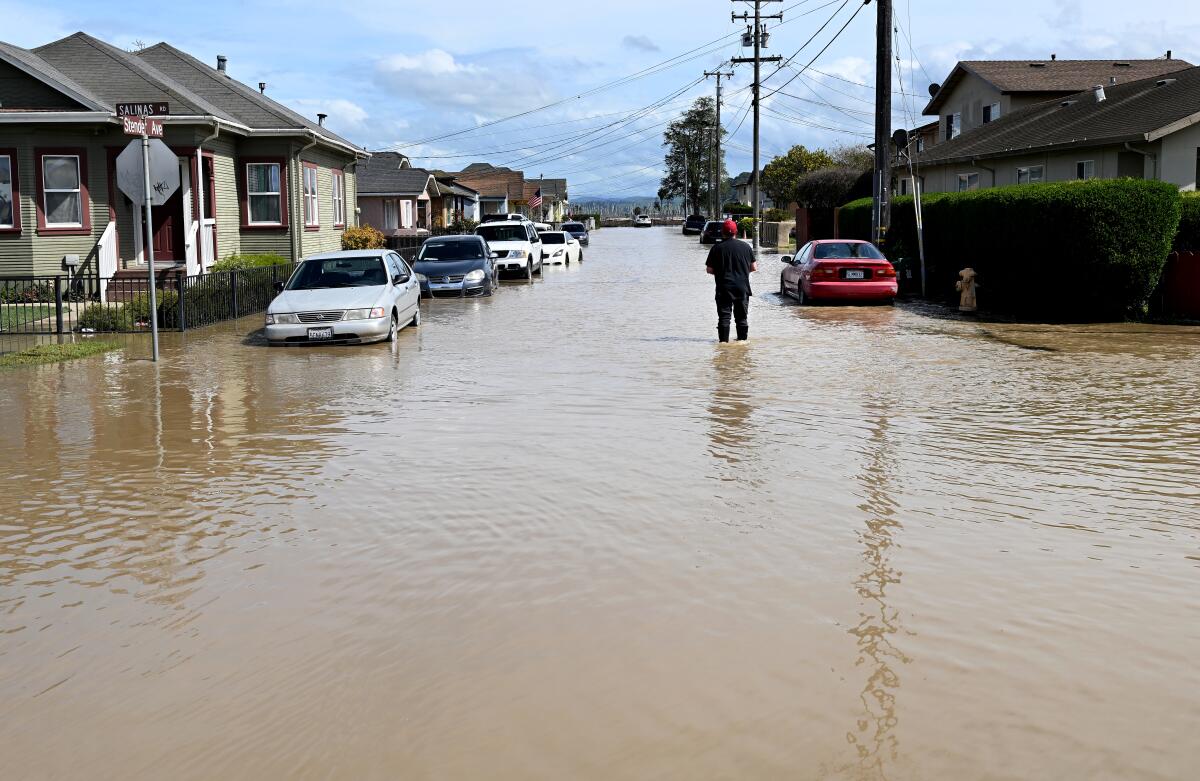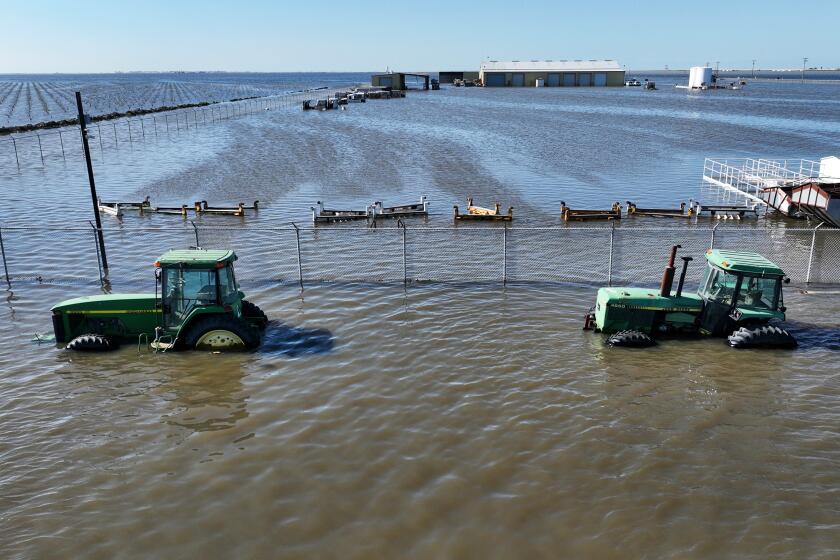In the wake of winter storm damage, Pajaro River flood-control efforts slide

- Share via
Just months after a levee failure inundated the small farmworker community of Pajaro, Calif., and sent thousands fleeing, cracks have already begun forming in the regional agency tasked with maintaining flood infrastructure.
After initially agreeing to provide a one-time payment of almost $1 million to help with infrastructure repairs and maintenance in the flood zone along the Pajaro River and its tributaries, the Santa Cruz County Board of Supervisors voted this week to withdraw the funding, saying the money was needed for other flooding issues in the county.
The move has dealt a blow to the Pajaro Regional Flood Management Agency — a joint powers authority created two years ago by the city of Watsonville and the counties of Santa Cruz and Monterey — and highlighted the difficulties local governments face when attempting to upgrade aging levees in an era of weather whiplash.
The river separates the two counties — affecting both jurisdictions — but is not fully contained in either. Since the formation of the counties, the river has proved a flood management headache for residents and lawmakers alike.
In a letter to Santa Cruz County supervisors, Luis Alejo, a Monterey County supervisor and board member of the flood agency, said that withdrawing the funds would undermine the agency’s “ability to advance important capital improvement repairs and projects” and “is not consistent with the notion of partnership embodied by the formation” of the agency.
“This is a big reason why work on these major types of flood protection projects often doesn’t get done,” he said in a text to The Times. “When budgets start getting tight or when new priorities arise, then resources and focus are pulled away from the Pajaro River levee project. And then we look back years from now and wonder why the work didn’t get done again.”
The Tachi Yokut Tribe is celebrating the return of California’s Tulare Lake, saying water should remain to heal an ecosystem that was drained for agriculture.
At issue is a Santa Cruz County flood management area, called Zone 7A, that is overseen by the county Board of Supervisors. The district receives about $100,000 per year as a result of new development fees. It has close to $1 million in the bank — which it committed to the joint powers authority.
Zone 7A, part of which runs along the river — but does not include Watsonville — also suffered flood damage. However, much of the damage had nothing to do with the flooding river.
Like much of the Central Coast, Santa Cruz County was hit with a series of destructive storms this past winter, which battered the coastline, flooded rivers, washed away roads and wreaked havoc in the mountains with landslides and power outages.
Jason Hoppin, a Santa Cruz County spokesman, said that as officials evaluated the storm damage, they realized they were going to need to use some of that money for non-river flood repairs in Zone 7A. They believed a cost-sharing agreement they’d made with the joint powers authority would allow for that.
So on June 14, Matt Machado, Santa Cruz County’s director of public works, appeared before the authority’s board requesting to use half of the $1 million for these other flooding projects.
His proposal was rejected in a 3-2 vote.
That refusal, said Zach Friend, a Santa Cruz County supervisor, prompted he and his fellow board members to withdraw Zone 7A from the authority. (Another Santa Cruz County flood district, Zone 7 — and its $3 million — remains a party.)
“People, in my opinion, don’t care how they were getting flooded; they just want it fixed,” he said, referring to his constituents who live in Zone 7A.
He dismissed concerns the move was going to affect the ability of the joint powers authority to operate or proceed with repairs on the levee, which is undergoing a major rebuild after years of neglect.
“It’s a $500-million project,” said Friend of the levee construction — with funds already committed by the federal and state governments. The withdrawal of the 7A funds “doesn’t impact the main project in any real way.”
For the first time since winter storms began filling the long-drained Tulare Lake basin, state officials have announced that floodwaters are abating.
Stu Townsley, the U.S. Army Corps of Engineers’ deputy district engineer for project management for the San Francisco region, agreed.
“The feds have obviously appropriated a chunk of the overall project costs, and the state has committed to cover almost all the non-federal cost share,” he said. “So I mean, from a financing standpoint, this thing is as good as gold. All the little local politics for, you know, $1 million or something under it are really budget dust in the grand scheme of things.”
Both Friend and Alejo are hopeful a compromise or solution can be found.
“We’re going to work out an agreement on this!” Alejo texted.
For years, the levee running along the Pajaro River had been neglected despite concerns about its decrepitude.
After it breached in March, Townsley told The Times the Corps had known for years “the levees were probably not adequate for the water that that system gets.” And despite the agency having studied it on and off for years in terms of “benefit-cost ratios,” it never penciled out, he said.
“It’s a low-income area. It’s largely farmworkers that live in the town of Pajaro,” Townsley said. “Therefore, you get basically Bay Area construction costs, but the value of property isn’t all that high.”
More to Read
Sign up for Essential California
The most important California stories and recommendations in your inbox every morning.
You may occasionally receive promotional content from the Los Angeles Times.
















